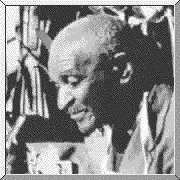 George
Washington Carver
was born near Diamond Grove, Missouri in 1864. At
time end of his birth, Carver was a slave (the Thirteenth Amendment
to the Constitution was not ratified until 1865). Moses Carver, his
mother's owner, adopted the child after his mother was kidnapped and
taken to Arkansas at the end of the Civil War.
George
Washington Carver
was born near Diamond Grove, Missouri in 1864. At
time end of his birth, Carver was a slave (the Thirteenth Amendment
to the Constitution was not ratified until 1865). Moses Carver, his
mother's owner, adopted the child after his mother was kidnapped and
taken to Arkansas at the end of the Civil War.
Carver attended elementary school at an all Negro school in a town near his foster parents residence. Since Carver was an Afro-American citizen living with Caucasian foster parents, he was denied an advanced education in Missouri schools. In 1889, George Washington Carver became the first Afro-American to enroll at Simpson College at Indianola, Iowa. Following his graduation from Simpson College, he attended Iowa State Agricultural College where he earned a master's degree in 1892. He joined the faculty of Iowa State Agricultural College and reminded on staff for the next four years.
In 1896, Carver left Iowa and joined the faculty of the newly founded Tuskegee Institute at Tuskegee, Alabama. Tuskegee Institute was founded by Booker T. Washington as a Negro college to help educate Afro-Americans who were denied a higher education at traditional institutions of the time. George Washington Carver became the director of Tuskegee's Department of Agricultural Research.
Decades of monoculture, the growing of only cotton and tobacco had depleted the soils of the southern area of the United States of America. Additionally, the economy of the South had been devastated by years of war and the plantation system which was dependent upon slave labor, which had been abolished. Carver set about the task of not only educating students, but of also restoring fertility to the land. Based on his knowledge of agriculture, Carver selected sweet potatoes and peanuts as crops which could be used to restore nutrients to the soil. In order to take care of the surplus peanuts and sweet potatoes, Carver undertook a series of studies of experiments to determine new uses for them. From peanuts, he developed more than three hundred synthetic materials including: milk and cheese substitutes, dyes, and soap. He also found 108 uses for the sweet potato and 75 uses for the pecan. Over his lifetime, he created 118 products including rubber and dye from 28 different plants.
In 1939, George Washington Carver was awarded to Roosevelt medal for restoring southern agriculture. During his lifetime, he was also the recipient of an honorary membership in the Royal Society of Arts in London and the Springarn Medal (1923). His boyhood home in Diamond, Missouri was made a national monument in 1943. He was the first Afro-American to have been honored with a national monument. George Washington Carver died in 1943 at the age of 79.
References
Asimov, I. (1964). Asimov's Biographical Encyclopedia of Science and Technology: The Living Stories of More than 1000 Great Scientists from the Age of Greece to the Space Age Chronologically Arranged. Garden City, NY: Doubleday.
Howard, A.V. (1951). Chamber's Dictionary of Scientists. London: Chambers.
Pearson, W., & Bechtel, H.K. (1989). Blacks, Science, and American Education. New Brunswick, NJ: Rutgers University Press.
Sammons, V.O. (1990). Blacks in Science and Medicine. New York: Hemisphere.